How to make Manhattan-style Fermented Pickles with Garlic and Dill! An easy step-by-step guide to making the most flavorful, crunchy, tangy pickles full of healthy probiotics with only 20 minutes of hands-on time! The pickle brine is like a “tonic” -drink a shot daily to support a healthy gut! Video.
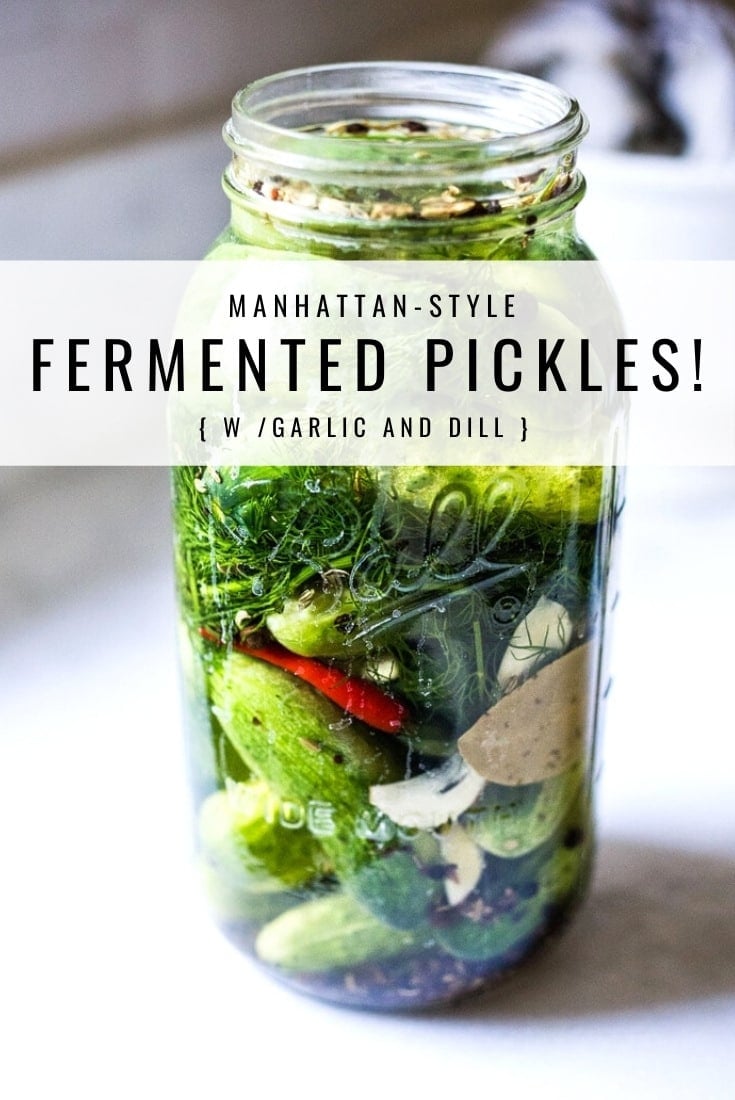
What happens when people open their hearts? They get better. ~Haruki Murakami
I’m excited to share this easy recipe for Fermented Pickles with you! If you are a crunchy pickle lover like me, you will be in heaven. Seriously, these are the best! These Manhattan-style “half-sour” fermented dill pickles are crispy, crunchy, flavorful, and oh-so alive!
Fermented in a salt brine, rather than vinegar, they get their delicious tanginess from light fermentation rather than vinegar.
Full of healthy, gut-healing, immunity-boosting probiotics these little guys are perfect as a low-calorie snack, or sliced and added to sandwiches or served as a tasty side.
Not only are they delicious and incredibly EASY to make, they are also incredibly good for us!
And as crazy as this may sound to some, the fizzy brine itself is like a healing tonic to me – I love to drink a shot of it- especially when I feel like my immunity needs a boost! So flavorful and totally energizing. Or try a Gin and Brine!
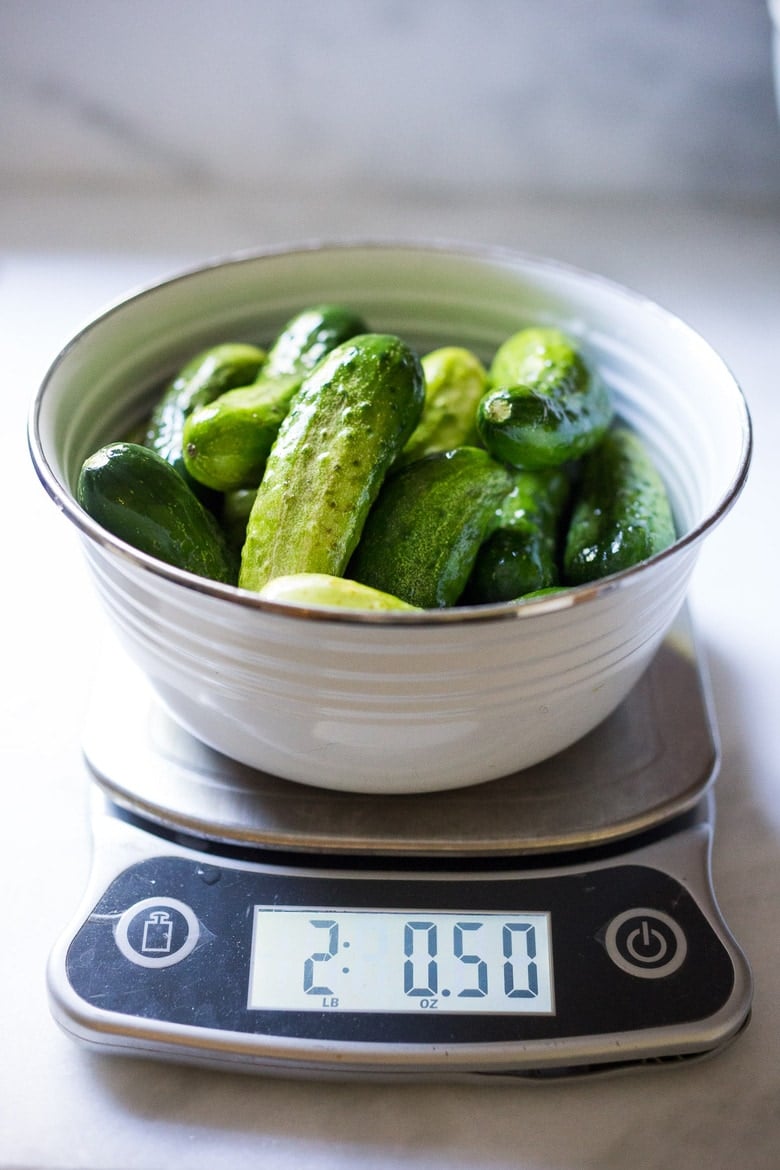
What you’ll need
- Pickling Cucumbers- Small and short (4 inches long) with thin bumpy skin, crisp texture, small seeds, a blocky shape and color gradient from light to dark. Varieties include Kirby, Calypso, Royal, Pickalot, National Picking, Adam Gherkin, Sassy, Eurika, Jackson, Boston Pickling, Northern Pickling… to name a few. You’ll need 2 lbs of “pickling cucumbers.” This recipe makes one large 1/2 gallon jar (or use two quart-sized jars) – a relatively small batch. Pickling cucumbers are most easily found at your local farmers’ market. Ask the farmers if they have “pickling cucumbers” they can help direct you to the right ones. Your pickles will only be as good as your cucumbers, so choose wisely! Make sure they are roughly the same size -about 4 inches long with 1 1/2-inch to 2-inch diameters – so they fit in the jar nicely and ferment at the same rate. I handpicked each one. They should be fresh and crisp with no soft spots.
- Salt-use fine sea salt, or fine Himalayan Pink salt
- Garlic and Onion – we load this up with 10-20 garlic cloves for the best flavor!
- Fresh Dill – use a big handful!
- Spices: Ground Turmeric ( adds fresh flavor) fennel seeds, mustard seeds, whole peppercorns, coriander seeds, whole allspice, dill seeds and celery seeds. Feel free to change or embellish! I added a couple of chilies for a little heat.
- Optional Tannic Acid: Bay leaves, grape leaves, oak leaves, or a couple of slices of fresh horseradish root. Cucumbers contain enzymes that soften them. To prevent this add a few bay leaves or a grape leaf to the jar.
- Two-Quart Mason Jar ( 8 cup mason jar)
- Fermentation weights
- Optional: Air lock, gasket, metal ring
How long does it take to ferment pickles?
These 3% Brined, half-sour crunchy pickles take 3-5 days of fermenting time.
The Brine: SALT TO WATER RATIO
- This recipe is a 3% salt water brine, which is considered “safe”. It equals 7 grams of salt per 1 cup of water. Or, 1 heaping teaspoon salt (1 1/4 teaspoon salt ) per 1 cup of water. This ratio allows one to drink the brine (like a shot) because it is not too salty and is designed for a shorter fermentation period ( 3-5 days). Crunchy, lightly fermented pickles!
- If you want a stronger brine for a longer ferment, feel free to go up to 4.5%. So for example, 3.5% Ratio= 9 grams of salt per 1 cup of water, 4.5% brine =10.8 grams of salt per 1 cup of water. For a 4.5% brine, half-sour pickles take 5-7 days, full sour pickles 14-21 days.
Fermented Pickles (step-by-step Instructions)
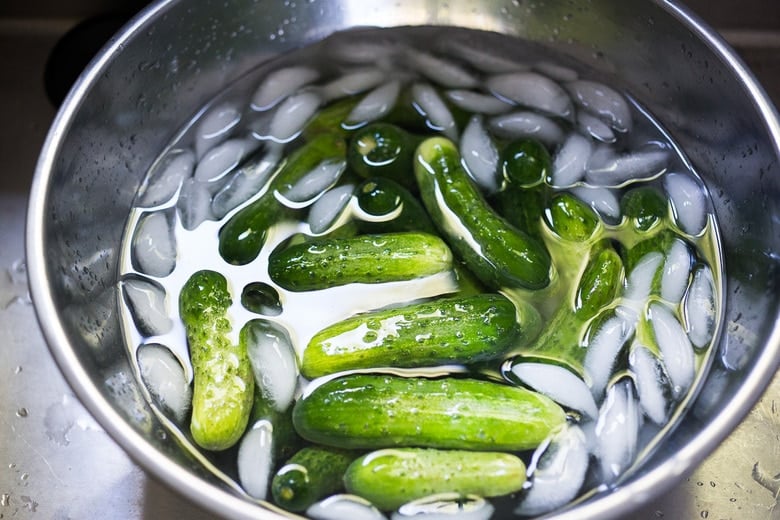
Step 1: Wash the cucumbers, slice off 1/16 inch of the blossom end, and soak them in an ice bath for 15-30 minutes to firm and crisp them up. There are enzymes in the blossom end that can make your pickles soft, so be sure to remove them.
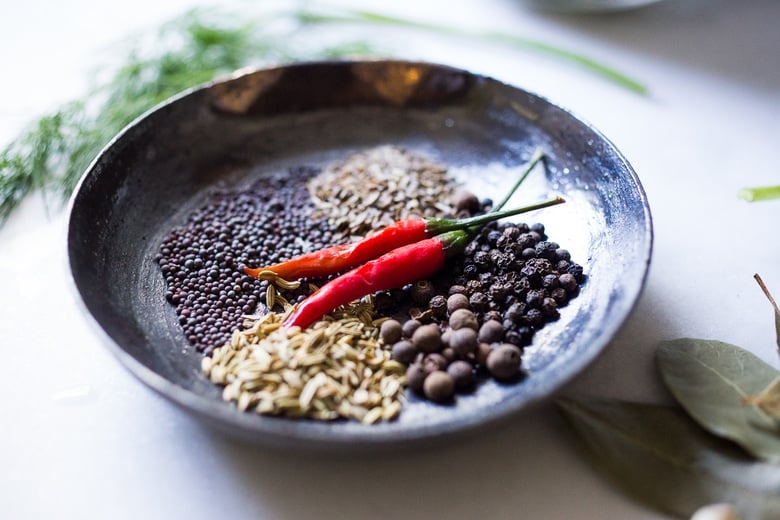
Step 2: Slice the garlic lengthwise and gather your spices.
Because these fermented pickles are left whole, you want the brine to be extra flavorful. I add a lot of garlic… 10-15 cloves, sometimes 20! Fermented Garlic is really good for the gut too!
Step 3: Place the spices on the bottom of the jar, then sliced garlic, fresh dill and bay leaves, and then add 2 layers of cucumbers, end on end, in a large two-quart jar (half-gallon). Press everything down.
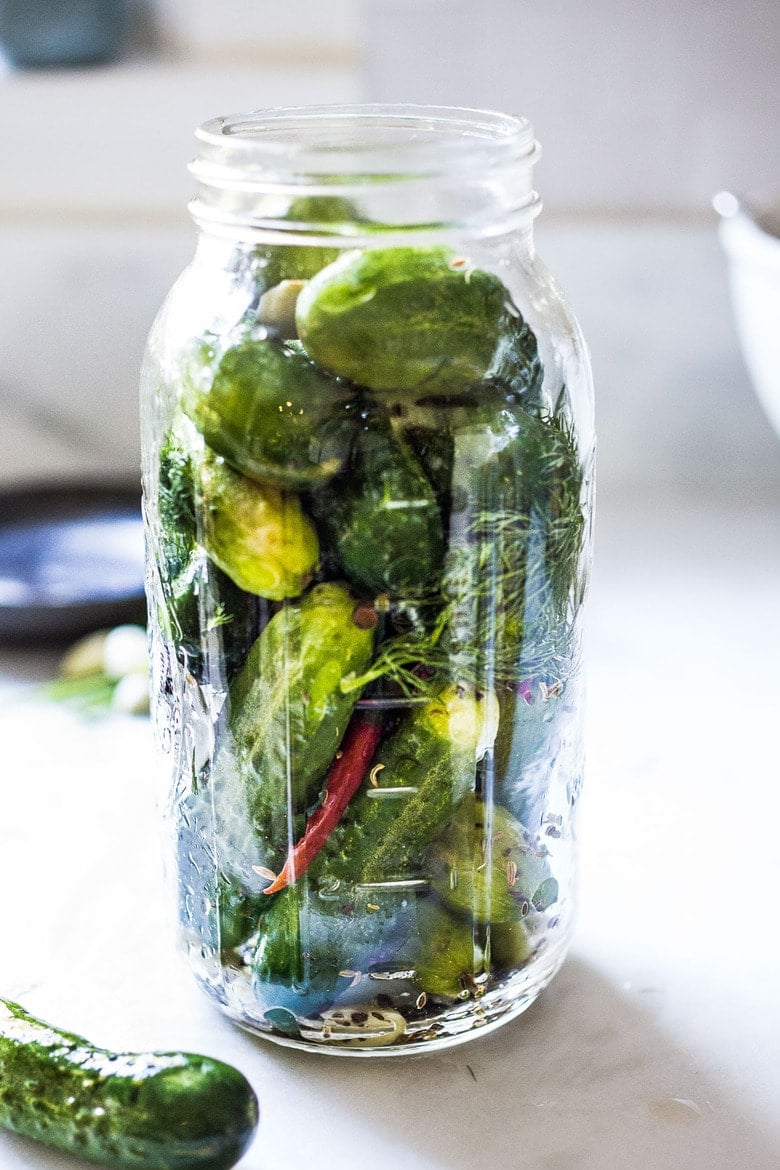
Step 4: Carefully measure and mix salt and water to create the 3% salt water brine- then pour this brine over the pickles leaving 1 1/2 inches of headroom.
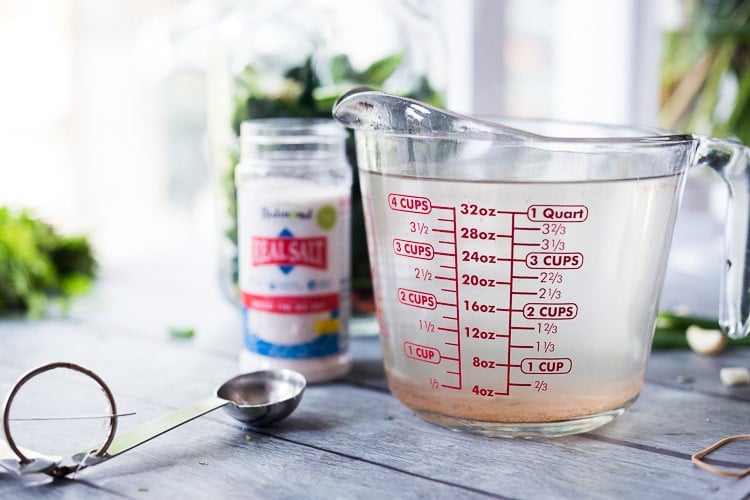
How salt works in fermentation:
- In a nutshell, using the right ratio of salt in fermentation encourages the growth of healthy bacteria while at the same time killing off bad bacteria. You want to be precise when measuring the salt and water in these kinds of recipes.
- Too much salt may kill off ALL of the bacteria -preventing fermentation.
- Too little salt will allow bad bacteria to keep on living. It is a fine balance. 😉
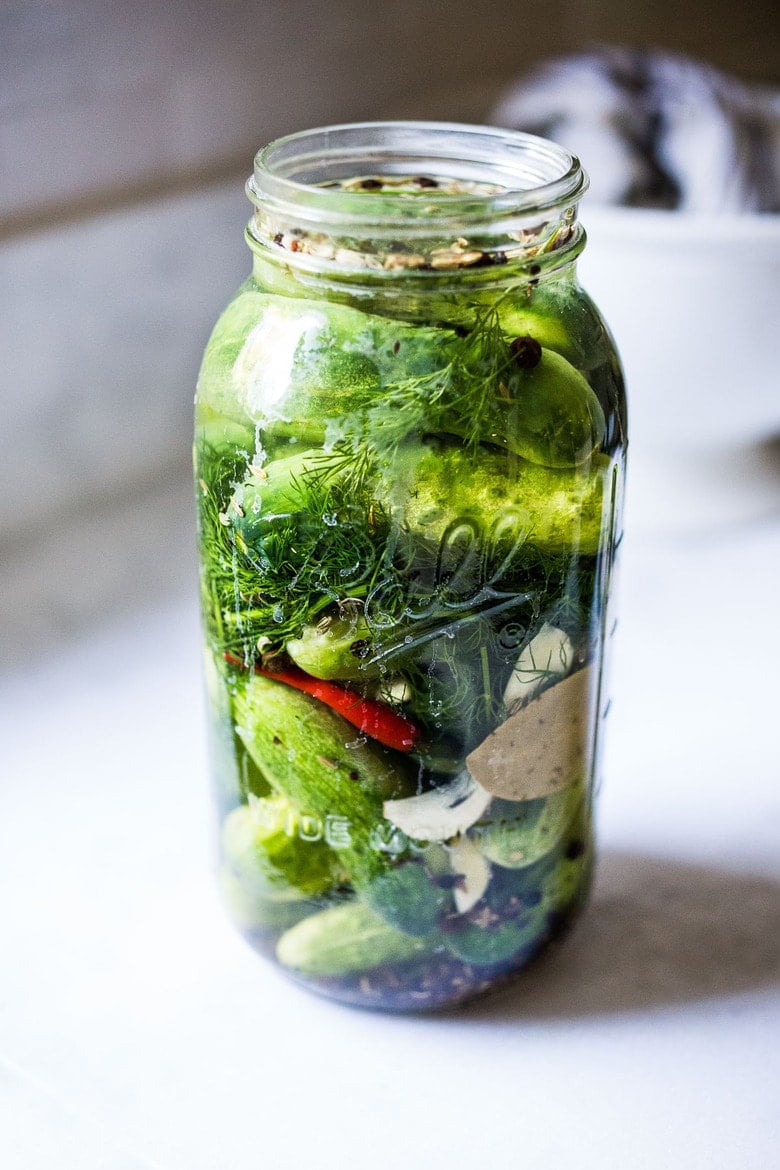
Step 5: Weigh down the cucumbers so they are completely submerged under the liquid, using a couple of fermentation weights, or a small zip lock bag filled with a little water (in a pinch).
MOLD: If the cucumbers or seeds are not submerged under the brine and become exposed to air- they can develop mold, so spoon any floaters out with a slotted spoon. Most seeds should stay submerged.
Step 6: Cover loosely with a lid or towel (to prevent bugs or flies from coming in, and to allow gases to escape) place in a bowl or pan to catch any overflow, and place in a cool dark place for 3-7 days, like the basement. You can also use and airlock lid- which allows air to escape, but nothing to fly in.
Step 7: Check after 2-3 days. Look for signs of life: bubbles/ or cloudy water. A cloudy brine is GOOD. Tap the jar and see if bubbles rise to the top. Check to see if any brine overflowed into the bowl ( both signs of life). This often takes about 3-5 days, I find 4 days is the “sweet spot”, depending on temperature. Cloudy brine is delicious and nutritious!
Step 8: Place the jar in the fridge to further slow the fermentation with a loose lid. They will continue to ferment very slowly and will keep indefinitely.
Expert Tips:
- Ferment at cooler temps (60-70F) to keep pickles crisp. If your home is hot, try placing in a cooler with ice. Take the temp of the brine.
- The longer you ferment them (unrefrigerated), the tangier they will get. But they will also get softer. I like them crisp, but you may want them tangier and softer. You can taste them at any point after you see bubbles.
- Smell: your ferment should smell tangy, garlic and fresh. If you notice anything foul or unpleasant, your ferment may have been contaminated: most commonly by dirty hands, dirty utensils, or a dirty jar.
- If you want to create a “fizzy” brine for drinking, tighten the lid, and burp daily if leaving out. You can tighten the lid in the fridge, but burp weekly. This will create a little pressure and give it some effervescence.
- Anything that touches air- may mold. Always fish out any floating spices with a slotted spoon to prevent this.
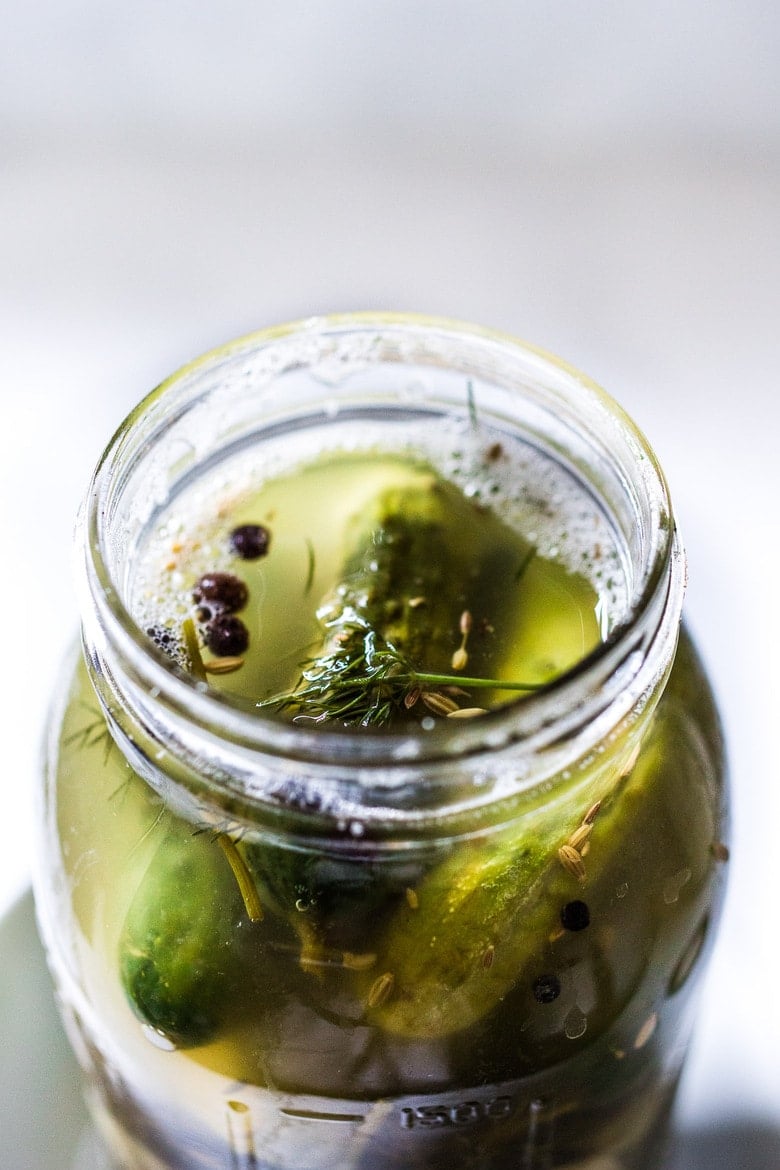
Once they are cold, give them a taste. They should be crunchy and flavorful! The brine is deliciously tangy, salty, and effervescent -so tasty and full of gut-supporting probiotics. The garlic is tasty too! Eat it!
I find myself often drinking shots of the brine! I also make this Gin & Brine Martini!
Let me know how you like this one in the comments below!
xoxoxo
More Favorite Ferments!
- Curtido & Cultured Salvadoran Slaw
- How to make Sauerkraut (Simple Cultured Cabbage)
- Beet and Cabbage Sauerkraut
- Cucumber Kimchi Pickles
- Turmeric Sauerkraut
More from Feasting at Home
How to make Fermented Pickles| 45-sec video
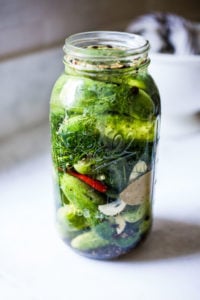
Homemade Pickles with Garlic and Dill
- Prep Time: 4 days
- Total Time: 4 days
- Yield: ½ gallon
- Category: fermented, preserved
- Method: fermented
- Cuisine: American
- Diet: Vegan
Description
How to make Manhattan-style, fermented Dill Pickles! A simple recipe for making the most flavorful, crunchy, tangy, garlic dill pickles with only 15 minutes of hands-on time. Full of healthy, gut-healing probiotics these little guys are perfect as a low-calorie snack, or sliced and added to sandwiches.
Ingredients
- 2- 2 1/2 lbs pickling cucumbers– all similar size ( 5 inches)
- 5 cups filtered water or tap water (that is not overly chlorinated)
- 2 tablespoons fine sea salt or Himalayan salt — or basically one heaping teaspoon fine sea salt (7 grams) per one cup of water, for a 3% brine (see notes)
- 1/4 teaspoon turmeric (optional, adds a “fresh” flavor)
- 1 teaspoon each: fennel seeds, coriander seeds, allspice, peppercorns, dill seeds, mustard seeds, celery seeds- and feel free to add more peppercorns!
- 10-20 garlic cloves, sliced (or double for extra garlicky)
- 1/2 onion, thinly sliced (optional)
- big handful of fresh dill
- 1-3 fresh red chilies – or dried arbol chilies, or add chili flakes (all optional)
- 3-4 bay leaves (or a grape leaf or oakleaf) – these are sources of tannic acid to help them stay crisp.
Instructions
- Prep Cucumbers: Rinse the cucumbers, remove 1/16-inch of the flower end of each cucumber (keeps them from getting soft) and place them in an ice-water bath, to crisp them up (15-30 minutes). Leave them whole.
- Make the brine: Mix salt (2 tablespoons) and 5 cups cold water until dissolved.
- Wash your hands, jar and any utensils. No need to sterilize, just clean!
- Assemble: In a large, clean two-quart mason jar, place all the whole spices into the bottom. Add the dill, garlic and onions or turmeric if using. With clean hands, pack one layer of cucumbers tightly, standing on end, then add the bay leaves, then add the second layer of cucumbers standing on end.
- Press everything down, leaving 1 ½ inches of headroom. Pour the salt water brine over the top and weigh down the cucumbers with fermentation weights so they are submerged under the brine. Remove any spices that may have floated to the surface (which can mold).
- Cover the jar loosely with a lid or with a cloth- basically, the pickles will bubble and you want air to be able to escape.
- Place the jar in a pan or bowl to collect any overflow and leave it in a cool dark place (60-70F) for 2 -3 days (a basement, or lower kitchen cupboard) and check for bubbles or overflow, indicating fermentation. Half sour pickles will take 3-5 days with crisp, white interiors. If is colder than 65F, it may take longer, if hotter, they will ferment faster. Full sour pickles will take 14-21 days (see notes for a stronger saltwater ratio).
- After 2 days, check for signs of life: bubbles, overflow, or clouding. Tap the jar, and see if tiny bubbles rise to the top. I usually ferment for 3-5 days. Longer ferments will yield tangier pickles but will get softer as they ferment, and lose their vibrant color. Up to you. You can taste them at any point after you see bubbles, and ferment longer if you like. The brine will get cloudy as it ferments- this is a good sign! Once you see active bubbles, you can at this point place the jar in the fridge, where it will continue to ferment, but much more slowly. Keep the pickles submerged.
- Once chilled, give them taste. They should be crispy and flavorful with a little tang. (At this point, if you want a tangier or softer pickle, you can absolutely pull them back out again and ferment for a few more days longer if you want.)
- If you like fizzy brine, tighten the lid, burping every week or so or try using an airlock. If you don’t want to think about it, give the lid one loose twist, so it’s on there, but gases can escape.
Notes
If you need more brine, make sure you use the same ratio- 1 heaping teaspoon sea salt per one cup of water.
If using a grape leaf, place it on the side of the jar, then layer the remaining ingredients.
If pickles turn out too soft- it may be due to too warm of temperature during fermentation, or the flower end wasn’t removed (the flower end of the cucumber has enzymes that can soften pickles).
Feel free to use 2, quart-size jars, dividing cucumbers, spices and brine between the jars.
BRINE: This recipe is a 3% salt water brine, which is considered “safe”. It equals 7 grams of salt per one cup of water. I’ve had really good luck with this ratio – and this ratio allows me to drink the brine (like a shot) this is really healthy – full of good gut-supporting bacteria!
If you want a stronger, saltier brine, feel free to go up to 4.5%. For a full sour pickle (14-21 days) use a 4.5% brine.
- 3% ratio = 7 grams salt per 1 cup of water. (1 1/4 teaspoon fine sea salt, per 1 cup water)
- 3.5% Ratio= 9 grams of salt per 1 cup of water. (1 1/2 teaspoon fine sea salt, per 1 cup water)
- 4.5% ratio 10.8 grams of salt per 1 cup of water. (2 teaspoons per cup of water)
Cutting the Cucumbers: I recommend leaving them whole. The texture is much better. After your first successful batch, feel free to experiment.
Nutrition
- Serving Size:
- Calories: 16
- Sugar: 1.3 g
- Sodium: 297.4 mg
- Fat: 0.2 g
- Saturated Fat: 0 g
- Carbohydrates: 3.7 g
- Fiber: 0.5 g
- Protein: 0.7 g
- Cholesterol: 0 mg
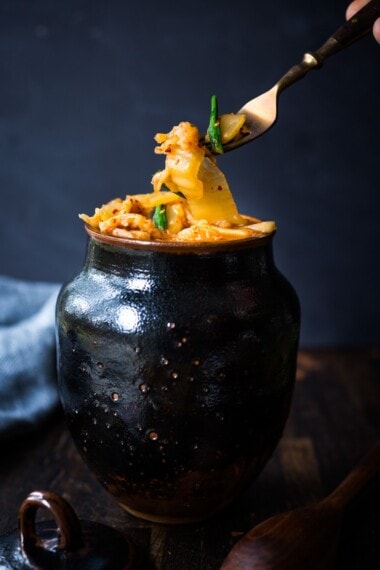
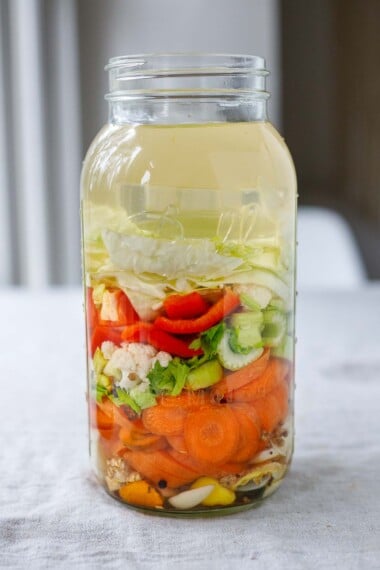
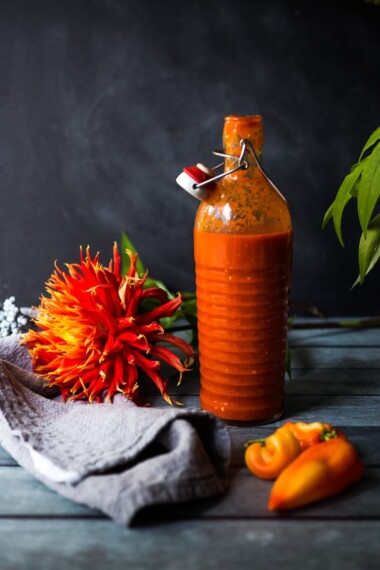
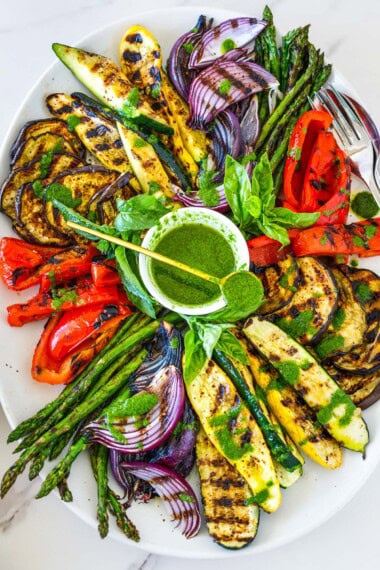



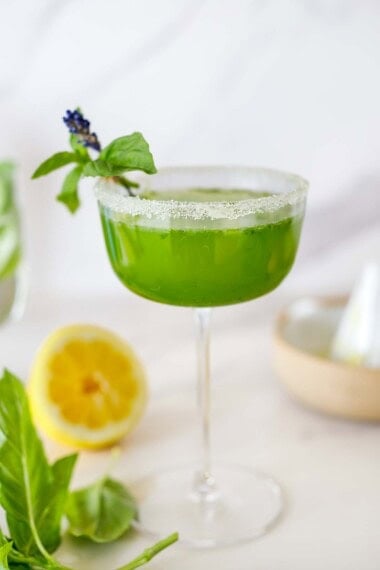
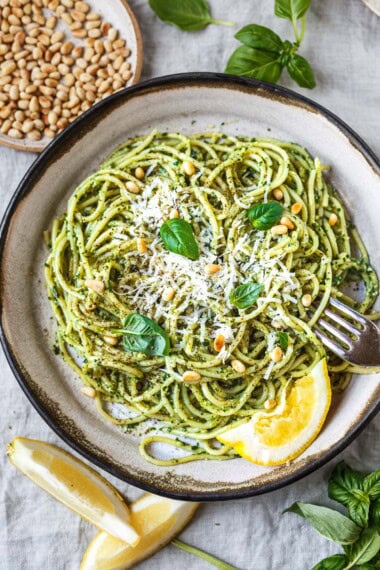
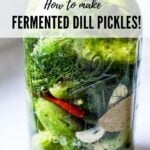
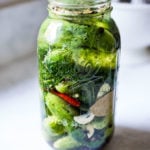
we use this recipe growing up. Made jars of pickles! Can’t wait to try it again. Mom is now 90 years old.
Ever tried this with spears or slices?
I just did! I made spears and it worked great!
Is it one teaspoon of salt per cup for just the initial one cup, or is it 6 teaspoons, one for each cup? Doesn’t seem very salty if I just brine the initial cup only in the directions.
Hi Tricia- mix 2 tablespoons fine sea salt with 1 cup of warm water. Then add 5 cups of cool water to this. So basically 1 teaspoon salt per 1 cup water. 🙂
Question If I follow your recipe on fermented pickles how long will they keep if I don’t refrigerate I’m looking to can cucumbers for a long time Like A year or two.thank you
Hi Joe, basically If you can them, you will kill all the healthhy bacteria, so there is not point in ferementing that I can see? I would just can them like you would normally using vinegar?
Hi, do the jars need to be sterilized? Do you know the best method?
Thanks!
Not necessarily, just clean- with hot water. 😉
I made recipe yesterday, today I peeked at jar & I already see bubbles. Any thoughts?
Sounds like it is doing good Renee, keep going. 😉
I used pink Himalayan salt and the liquid is really cloudy. I sure hope I didn’t ruin a large 6-cup batch of pickles!
That is fine! Read the recipe notes- cloudy brine is fine!
Just made this recipe. I used 2 quart jars and ended up with way more brine than I needed. Both jars were completely full of brine too !
Did you happen to weigh the pickles? It may be something with using two jars vs. one large one, and how the pickles fit in there?
I did weigh them. But instead of whole cucumbers I cut them in chips so maybe that’s why 🤷. I found the brine made 3 quarts worth. We’ll see in 3 days how they taste! Thanks for the recipe!
Oh ok interesting!
I added onions
A friend of mine just did these for the first time and I am hot on his heels to do it myself. They were fantastic! We live in the South though, so he used muscadine leaves instead and they worked like a charm. This is going to quickly become a habit.
Awesome Sean- let me know how it turns out!
I usually make a cup of tea and add the used teabag to the brine. I find the tannic said helps keep the pickles crunchy. For me it works better than a grape leaf or Bay leaf.
Love this idea Rico, thanks!
If I’m using two quart sized jars, do I half the recipe? Like with the 1 tea spoon spices, that would be 1/2 tsp per quart sized jar. Correct?
You keep the same recipe amount but divide among the two jars (half recipe in each jar).
Do we let the brine cool all the way down before putting it over the pickles, or as mentioned is cooling to just room temperature fine?
Cheers!
Cooling to room temp is great!
That recipe looks so incredibly delicious. FYI- it’s champing at the bit.
Slicing off the Blossom end of the cucumber will also help greatly in keeping your pickles crisp! There is an enzyme in the blossom end of a cucumber that starts the rotting process so that the seeds will be released to grow. By removing this you will stop this enzyme from permeating the pickle and making it soft!
Love it Michael- thanks!
I use a recipe for canning in a vinegar brine that calls for 1 tsp of the same spices per 16 oz jar. I like the flavor. So is there any reason not to use at least that much in this recipe, per 32 oz jar? Thanks!
That should work great!
I have always made my pickles in a vinegar brine. I decided to try fermenting them as I had success with sauerkraut.
Thank you for a great tutorial! It was so easy and my pickles started to bubble after the first day. I made my brine at 3% and it was perfect.
Congrats! Great to hear!
There is no such thing as a ‘fermented’ brine that includes vinegar. Vinegar kills the living probiotic benefits of a fermented brine – making it preserved.
Hi David,
I did some reading and found out that raw apple cider vinegar will not kill the probiotics in the brine, but will slow down the fermenting process. The recipes I checked out used only one tablespoon of ACV.
Thanks so much Vera- I really appreciate your reserch into this! So helpful!
Love, love, love this recipe! They come out perfect every time, they taste like store bought pickles but much better. I slice them for rounds and spears and still turn out wonderfully, we always make sure we have some in hand so we don’t have to go without. Thank you for posting this recipe!
Yay Jenn- glad this is working for you!
The recipie looks great. What’s the shelf life? Thanks!
If kept in the fridge they will last months!
Thanks for this. I just bought a fermentation crock and was hoping I didn’t mess up by adding pickling spices. I’ve got more pickling dukes then I know what to do with.
sounds like fun!
I like the flavor to really get into the pickle, and would like to cut them. Does cutting the cukes cause a problem in the fermenting process in any way?
No, it should be ok, they may ferment quicker though.
Why can’t people use teaspoon measurements instead of grams. I don’t have a scale but I have measuring spoons. Don’t make no sense to me to do that unless I’m on a chefs site by accident. I guess that could happen. Sorry.
If you read the notes, the conversion is right there (teaspoons in parenthesis):
2.5% ratio = 6 grams salt per one cup of water. ( 1 teaspoon fine sea salt, per 1 cup water)
3% ratio = 7 grams salt per 1 cup of water. (1 1/4 teaspoon fine sea salt, per 1 cup water)
3.5% Ratio= 9 grams of salt per 1 cup of water. ( 1 1/2 teaspoon fine sea salt, per 1 cup water)
To answer your quesiton: Because weights and volume correlate depending on how your salt is ground and processed, it could weigh as much as 30% less for a given volume like a tablespoon. This is really important in fermentation because too little salt would be considered unsafe, and could give you a dose of botulinum to go with your pickle. If using volumes, please be safe and confident in your conversions. Scales can be had on Amazon for as little as $20-30, and I find them to be an essential tool for consistent and good quality cooking.
The main reason to use weight instead of volume is accuracy and consistency from batch to batch! Volume measurements can be off by as much as 25% because of varying sizes of spices and grains. This is the reason professional cooks and especially bakers weigh their ingredients as the volume can vary so much that it is difficult to get consistent results with volume. Take salt for example! The difference in weight from one brand to another can be considerable if you use volume so in pickling your amount of salt can be off by as much as 25%, but if you weigh your salt you get the same amount regardless of the grain size or if it is flaked or not, ETC. Also if you are making say a 3% brine, using weight makes it simple. for a Liter of water you add 30 grams of salt. A liter of water is 1000 grams so 3% of 1000 is 30.
I love this recipe. We have used it to make 5 batches now. My family now won’t eat any other pickles. We live in a tropical climate and only have to leave them out for 2-3 days then they are ready. We also use them in homemade tartar sauce! AMAAAAZING!
Horseradish leaves will also work as tannin for crispy pickles too.
Sylvia, thanks for this great recipe! I made a batch and they are ready today. The brine looks darker than I expected, not really too cloudy but a little murky. They smell great and I tasted a smidge of the brine and they seem fine. I’m thinking the darker color is from the seeds etc? I’ll taste one after they are cold.
Yes, try after chilled. 🙂